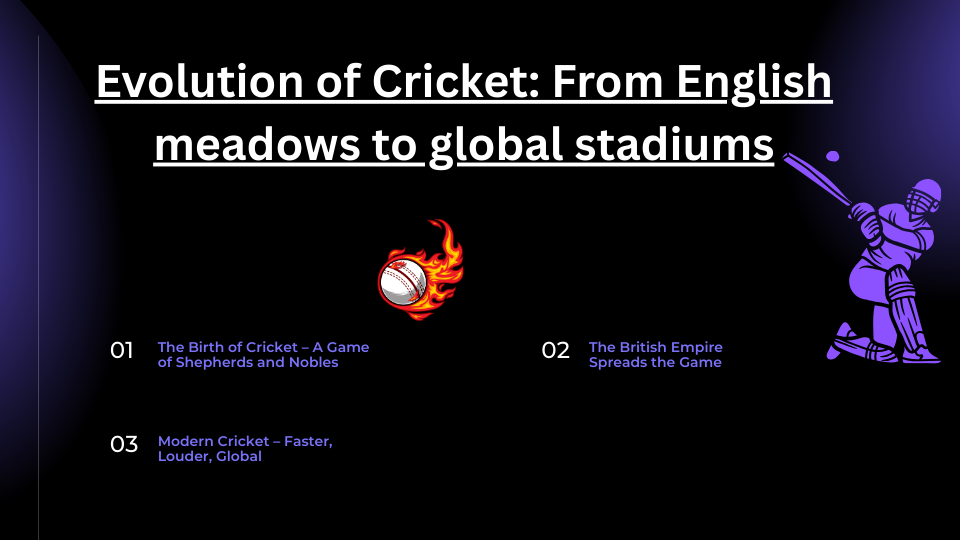While cricket is famous worldwide, the evolution of cricket remains a hidden story. Here we are going to study about cricket and it’s history.
Introduction
A quiet village in 16th-century England, where shepherds and farmers pass their leisure time hitting a ball with a curved stick. Fast forward five centuries, and that simple pastime has become a multi-billion-dollar global phenomenon, uniting nations and creating legends.
Cricket’s journey is unlike any other sport. It wasn’t just about rules and matches—it was shaped by empires, wars, cultural revolutions, and the sheer passion of millions. From its murky medieval origins to becoming the heartbeat of countries like India, Australia, and the West Indies, cricket’s story is one of resilience, adaptation, and unshakable tradition.
In this deep dive, we’ll uncover how cricket began, how British colonialism turned it into a worldwide obsession, and how different nations made the game their own.
Key points

The Birth of Cricket – A Game of Shepherds and Nobles
The Mysterious Early Days
Unlike football or tennis, cricket doesn’t have a clear “inventor” or founding moment. The earliest clues come from Tudor England, where children in the southeast played a bat-and-ball game called “creckett” (as recorded in a 1598 legal case). Some historians believe it evolved from older games like “stoolball,” where players defended a wooden stool with a bat.
By the 1600s, cricket had grown from a children’s diversion to a popular adult pastime, especially in Kent, Sussex, and Surrey. Villages would compete in raucous matches, often with heavy betting involved. In fact, the sport’s reputation was so rowdy that Puritan leaders tried to ban it in the 1650s!
The First Rules: From Chaos to Order
Early cricket was wild—matches could last days, rules changed by the village, and equipment was makeshift. The first attempt to standardize the game came in 1744, with a handwritten code that introduced:
- A 22-yard pitch (still used today)
- Three-stump wickets (earlier versions had just two)
- The concept of “leg before wicket” (LBW)
But the real turning point came in 1787, when the Marylebone Cricket Club (MCC) was formed at Lord’s. The MCC became cricket’s lawmaker, refining rules and shaping the modern game.
The British Empire Spreads the Game
Cricket didn’t just spread—it was weaponized by the British Empire. Colonial officers used it to instill “British values” in their colonies, but locals didn’t just adopt the game—they transformed it.
Australia: The Birth of Test Cricket and the Ashes Legend
British convicts and soldiers brought cricket to Australia in the early 1800s. The first recorded match was in 1803 in Sydney, played on a rough field with kangaroos occasionally interrupting play!
The real explosion came in 1877, when Australia and England played the first official Test match at the MCG. But the rivalry reached mythic status in 1882, when Australia won at The Oval. A British newspaper published a mock obituary:
“In affectionate remembrance of English cricket… The body will be cremated, and the ashes taken to Australia.”
Thus, The Ashes was born—a tiny urn (allegedly containing cricket’s ashes) that became the sport’s most famous trophy.
India: From Colonial Tool to National Religion
The British East India Company introduced cricket to India in the 1700s, but for decades, it was a sport for elites. The Parsi community in Bombay (now Mumbai) was the first Indian group to embrace it, forming the Oriental Cricket Club in 1848.
But cricket’s true revolution came in 1983, when Kapil Dev’s underdogs won the World Cup. Overnight, cricket became India’s heartbeat. Today, the Indian Premier League (IPL) is a cultural phenomenon, and players like Sachin Tendulkar are worshipped like deities.
The West Indies: How Slavery’s Legacy Created Cricket’s Most Feared Team
In the Caribbean, cricket was initially a white colonial sport. But after emancipation, former slaves took up the game—and turned it into an art form.
By the 1970s-80s, the West Indies dominated world cricket with a style called “Calypso Cricket”—fast bowling, explosive batting, and unmatched swagger. Players like Viv Richards and Malcolm Marshall didn’t just win; they intimidated.
Modern Cricket – Faster, Louder, Global
The 21st century has transformed cricket in ways its 16th-century inventors could never imagine:
The T20 Revolution
- The 2007 T20 World Cup changed everything—matches lasted just 3 hours, perfect for TV.
- Leagues like the IPL, Big Bash, and PSL turned cricket into a year-round spectacle.
Women’s Cricket Breaks Barriers
- Once ignored, women’s cricket now fills stadiums.
- Stars like Ellyse Perry (Australia) and Harmanpreet Kaur (India) are household names.
New Nations Rise
- Afghanistan, a team born in refugee camps, now competes in World Cups.
- Ireland and Nepal are producing world-class players.
Why Cricket Will Never Die?
Cricket’s magic lies in its ability to adapt. It survived Puritan bans, world wars, and even the rise of football. Today, it thrives because it’s more than a sport—it’s a shared language across continents.
From the green fields of 16th-century England to the electric atmosphere of an IPL night match, cricket’s journey is a testament to human passion. And with new formats, technologies, and nations joining, its story is far from over.
If you are from India and interested in cricket then you should also read:- India’s top 10 wins against Pakistan in cricket